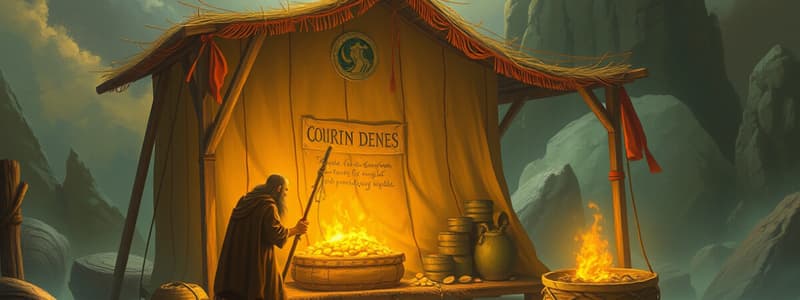Podcast
Questions and Answers
What is a primary disadvantage of the barter system?
What is a primary disadvantage of the barter system?
- It requires a common measure of value. (correct)
- It allows for easy measurement of value.
- It facilitates the exchange of currency.
- It promotes the exchange of diverse products.
Which type of money is primarily characterized by being easily perishable and indivisible?
Which type of money is primarily characterized by being easily perishable and indivisible?
- Metal money
- Ancient coins
- Commodity money (correct)
- Fiat money
What characteristic made metal an advantageous form of money?
What characteristic made metal an advantageous form of money?
- Its scarcity and high cost
- Its malleability and beauty (correct)
- Its large size and weight
- Its perishable nature
Why were gold and silver particularly valued in ancient civilizations?
Why were gold and silver particularly valued in ancient civilizations?
What was a significant advantage of metal in ancient trade?
What was a significant advantage of metal in ancient trade?
Which of the following was a form of money that emerged in the 7th century B.C.?
Which of the following was a form of money that emerged in the 7th century B.C.?
What was a critical aspect of the transition from simple metal use to coinage?
What was a critical aspect of the transition from simple metal use to coinage?
What role did commodities like cattle and salt play in early economies?
What role did commodities like cattle and salt play in early economies?
What is the main function of money as a unit of account?
What is the main function of money as a unit of account?
Which type of money is authorized by a central bank and does not have intrinsic value?
Which type of money is authorized by a central bank and does not have intrinsic value?
Why is scarcity considered an important characteristic of money?
Why is scarcity considered an important characteristic of money?
Which of the following options is an example of commodity money?
Which of the following options is an example of commodity money?
What is a key goal of an economy concerning employment?
What is a key goal of an economy concerning employment?
Which characteristic of money allows it to be broken down into smaller units for purchases?
Which characteristic of money allows it to be broken down into smaller units for purchases?
What is one of the critical functions of money in economics?
What is one of the critical functions of money in economics?
What is one primary function of money in modern economies?
What is one primary function of money in modern economies?
How did the practice of using paper money originate?
How did the practice of using paper money originate?
Which characteristic distinguishes electronic cash (eCash) from traditional forms of money?
Which characteristic distinguishes electronic cash (eCash) from traditional forms of money?
Which forms of money are considered part of the monetary system in a country?
Which forms of money are considered part of the monetary system in a country?
What is a significant trend concerning the use of coins compared to bank notes?
What is a significant trend concerning the use of coins compared to bank notes?
What does the term 'monetary mass' refer to in an economy?
What does the term 'monetary mass' refer to in an economy?
Why is money considered to have no intrinsic value?
Why is money considered to have no intrinsic value?
Which characteristic of checks enhances their use in daily transactions?
Which characteristic of checks enhances their use in daily transactions?
Flashcards are hidden until you start studying
Study Notes
History of Money
- Barter system utilized merchandise exchange without a common value measure.
- Commodity money emerged from sought-after items like cattle, salt, and cloth, but was inconvenient for trades.
- The discovery of metal allowed for the creation of durable, divisible, and beautiful items, enhancing trade value.
- Ancient coins first appeared in the 7th century B.C., primarily made from gold and silver.
- Early civilizations associated gold with the sun and silver with the moon, attributing magical properties to these metals.
- Paper money originated from goldsmith receipts, which evolved into a circulating form of payment.
- A monetary system comprises the coins and banknotes used in a country, with larger values typically represented as notes.
- Coins are generally more durable than notes, making them suited for daily transactions.
- Checks represent a dematerialized form of money, providing security and ease of use.
- eCash, or electronic cash, is a digital form of currency ensuring secure and anonymous transactions through encryption.
Significance of Money
- Money facilitates consumer choice by allowing individuals to receive income and make purchases efficiently.
- Although not a direct factor of production, money supports economic activities by preserving value over time.
- Acts as a unit of account by offering a common measurement for valuing goods and services.
Characteristics of Money
- Divisible: Must be easily divided into smaller units for varied purchases.
- Durable: Should withstand frequent handling without degrading.
- Portable: Must be easy to carry for convenient transactions.
- Acceptable: Widely recognized as a medium of exchange.
- Scarce: Must maintain a limited supply to retain value.
- Stable: Its value should remain relatively constant over time.
Kinds of Money
- Commodity Money: Items with value independent of their use as money, e.g., gold and silver.
- Fiat Money: Government-authorized currency not backed by physical commodities, e.g., the Philippine peso and British pound.
Money and the Economy
- Economics focuses on efficient resource allocation to satisfy human needs amid limited resources.
- Goals include full employment, ensuring those willing to work can find jobs, which in turn boosts national productivity.
Studying That Suits You
Use AI to generate personalized quizzes and flashcards to suit your learning preferences.




